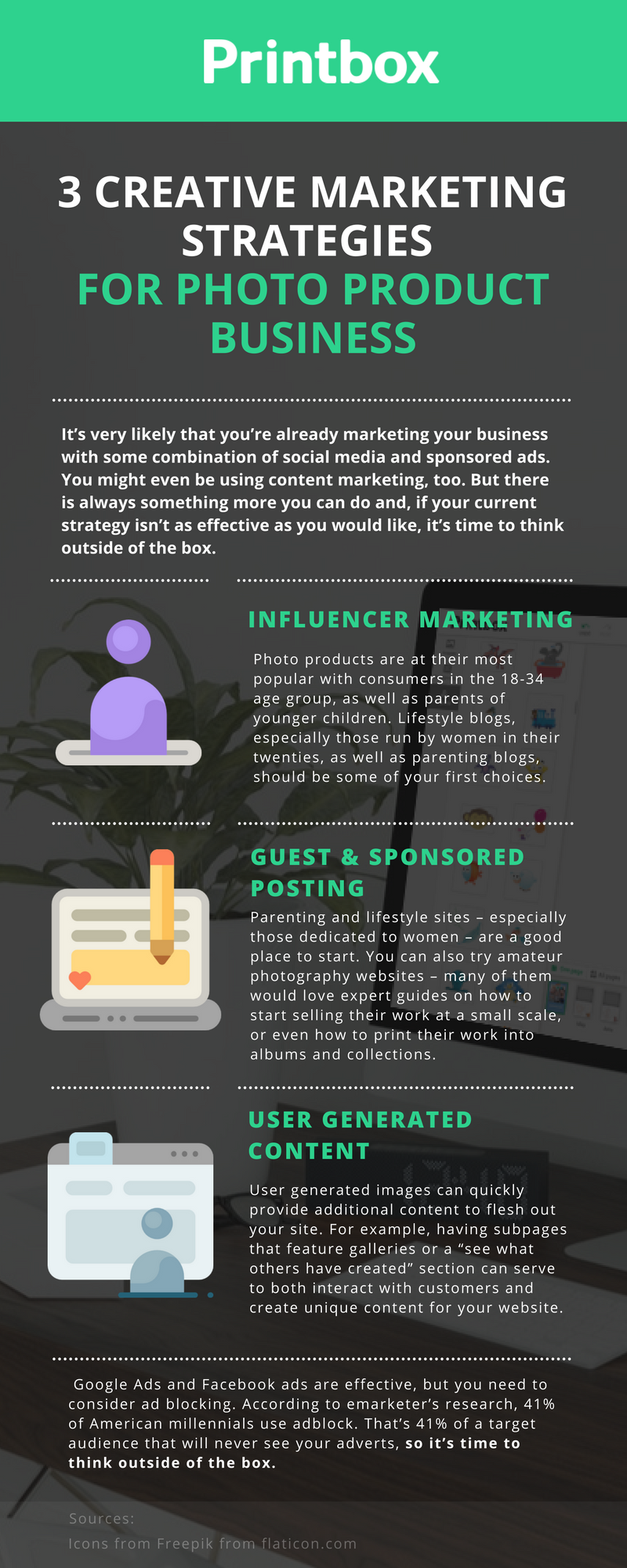It’s very likely that you’re already marketing your business with some combination of social media and sponsored ads, whether it’s Facebook or Adwords campaigns. You might even be using content marketing, too. But there is always something more you can do and, if your current strategy isn’t as effective as you would like, it’s time to think outside of the box. In this article, we explore 3 new strategies that photo product sellers rarely use, but are definitely worth your consideration.
The most successful marketing strategies require a large helping of creativity. This is only natural: to stand out from your competition, you need a little originality.
For photo product sellers, this means employing a diverse strategy. Google Ads and Facebook ads are effective, but you need to consider ad blocking. According to emarketer’s research, 41% of American millennials use adblock. That’s 41% of a target audience that will never see your adverts, so it’s time to think outside of the box.
So, where should you start? Here are three new strategies that are worth considering.
Influencer Marketing
If you’re not familiar with the concept of influencers, it refers to people with a large following on social platforms, such as blogs, youtube channels, instagram accounts and various other websites. Their extensive audience follows them for various reasons, such as for advice, shopping inspiration or product recommendations in a certain niche.
So, should your business be engaging with influencers?
In short? Yes. One study found that more than 80% of marketing campaigns, that involved social media influencers in their strategy, were effective in improving brand engagement and consumer awareness. Another study found that, on average, $1 spent on influencer marketing created $6.50 in revenue. So, done right, the rewards speak for themselves.
Influencers often receive products from the likes of cosmetic and clothing companies, but who’s to say they wouldn’t also appreciate some photo products? Many lifestyle bloggers love to discuss gift guides for popular holidays, such as Christmas, Valentine’s day and even the likes of mother’s and father’s day.
Offer them a free photo product from your collect so they can feature it in a blogpost or video. You can also offer more products for them to give to one of their followers. When starting out on this path, you will often find that smaller bloggers are happy with these terms, while those with larger audiences may ask for an additional “salary” for their help. After all, giving away products through contests and promotions takes time and effort.
When approaching a blogger, remember to treat them well and respect their conditions. If they ask for too much, simply tell them you won’t be able to meet their expectations and thank them for considering your products. Always keep in mind that, while they can use their audience to help you, it can also be used to give you a bad reputation.
Finding Influencers
According to a survey by Schlesinger Associates, one of the biggest challenges of influencer marketing is finding the right partner. This is an absolutely vital step of the process. You can’t just work with anybody: you need someone whose audience has a strong interest in your photo products.
Furthermore, influencers can help you with both short-term sales boosts and long-term success. Many bloggers offer SEO-optimization, so your marketing efforts will further boost your site’s visibility. This is something you should keep in mind when deciding who to work with.
Aside from this, Schlesinger Associate’s respondents mentioned engagement tactics, performance measuring and being able to keep track of an influencer’s activity as additional factors to consider.
Yet, arguably, the biggest factor will always be relevance. Photo products are at their most popular with consumers in the 18-34 age group, as well as parents of younger children. Lifestyle blogs, especially those run by women in their twenties, as well as parenting blogs, should be some of your first choices.
However, having the right topic isn’t everything – make sure you pay attention to the influencer’s content, as it might not always be relevant.
After this, you need to look at the traffic. You can often find recent rankings for the most popular blogs in your country, while Similarweb is a great tool for checking traffic. Be aware that the very top bloggers will come with a higher price tag, but you can usually aggregate by category and choose a less popular blogger that still has a strong following.
Once you’ve found a possible blog, check how often they post content and if they get any comments – a sure sign of user engagement. Look for blogs which have a strong engagement with readers, who value the influencer’s opinions. On the other hand, if the majority of the content sounds like sponsored posts and promotions, you should look elsewhere. If it’s obvious to you, the blog’s readers likely know this as well: they’re just there for giveaways and discounts.
Overall, the influencer strategy takes a lot of planning to get going, as well as a significant portion of your budget, but the results are often worth it!
Guest & Sponsored Posting
Another method of reaching someone else’s audience is to use direct guest and sponsored posting. Don’t just use content on your own website – this will only reach your existing audience.
Try reaching out to online lifestyle magazines and blogs that offer a guest posting service – there are many such lists available on the internet. The websites you choose, however, will depend on what outcome you wish to achieve. If you want greater exposure and traffic, you should find websites with a large, engaged audience that has a potential interest in photo products. This will often require more from your budget, because few web owners will accept a promotional article for free. Even if you’re paying for the content, make sure it is valuable to the site’s readers and matches the existing style – don’t make it too obvious that your content is sponsored.
On the other hand, if you’re only interested in building backlinks for SEO, you can find smaller blogs that accept guest posts for free. Just make sure to stick to their guidelines and provide them with valuable content for their site.
Furthermore, you may also be able to get free content if you provide true, expert value, in the form of content and knowledge that isn’t available elsewhere.
When it comes to the success of guest posting, finding the right sites is key, so how can you do this? Just as with influencers, parenting and lifestyle sites – especially those dedicated to women – are a good place to start. You can also try amateur photography websites – many of them would love expert guides on how to start selling their work at a small scale, or even how to print their work into albums and collections. These sites will have a strong, relevant interest in your photo books and canvases.
User Generated Content
For our third and final strategy, how about a campaign that lets others create content for you? Developing your own content for every possible need can be a burden in both time and resources.
This is especially true when it comes to pictures. You should always avoid using stock photos for e-commerce but, at the same time, you don’t want to print photo products every time you need a new photo to showcase your goods. So what’s the solution?
While you will still need professional photos for your main pages, user generated images can quickly provide additional content to flesh out your site. For example, having subpages that feature galleries or a “see what others have created” section can serve to both interact with customers and create unique content for your website.
As they say, a picture is worth a thousand words, and seeing what others have been able to create with your service is a fantastic way to convince other users to make a purchase. A photograph can showcase how beautiful your products are in a way that is simply impossible via a text review.
It’s also a great way to engage with your existing audience – so long as you give them motivation. They might not be keep on taking photos for free, so try offering some sort of contest. Ask your customers to post photos of what they ordered – using a certain hashtag on instagram, for example – and host unique, themed competitions such as “best holiday photo product” or “most creative valentines gift”. This content can then be used in blog posts, social media and other dedicated pages and spaces on your website!





